by Winding Pathways | Jan 30, 2017 | Mammals, Nature

These big cats have over 40 names. (Courtesy NYPL free digital file.)
Early one December evening a neighbor was driving home near our home when she spotted movement out of the corner of her eye. Thinking a deer was about to dart in front of her car, she immediately stopped to prevent a collision. She was astounded when a mountain lion crossed about ten feet in front of her illuminated by headlights.
A mountain lion………in Iowa! Perhaps that’s not so farfetched. Our neighbor would know one when she saw it.
Mountain lions (Puma concolor) are spreading out from their traditional home in western mountains. A couple of decades ago the only known eastern population of the big cats was in Florida, where they are extremely rare and are usually called panthers. These big cats were once common throughout North America except for the far north. They also ranged throughout all of Central and most of South America. As big predators they were heavily persecuted by humans, and their habitat was devastated by settlement. A big blow to cougars was the elimination of deer from much of their range in the late 1800’s.
Much has changed to give lions, or cougars as they are sometimes called, an opportunity to expand.
Most people now appreciate them as beautiful animals and don’t shoot them on sight. Many states protect them from shooting. Also, the woods and deer have returned. In 1900 most of what today is a vast hardwood forest that stretches from the Mississippi River to the Atlantic Ocean was farmed. Many of those farms went out of business and trees move in. Today, there’s near continuous forest for hundreds of miles and much of it is filled with deer, a favorite food of mountain lions.
A few years ago a male cougar walked from his Black Hills home to Connecticut, where he was hit and killed by a car. Most Midwest states have documented the presence of cougars. A few have been hit by cars. More have been photographed by trail cameras put out by hunters to track deer movement. Some have been shot. Seeing a live one is very rare.
So, a cougar sighting near Winding Pathways in Iowa is neither impossible nor surprising. It was probably a young male cat seeking a mate and place to live.
Do mountain lions pose a threat to people, livestock, or pets? Not really. There have been documented cougar attacks on people, mostly in California where they are not hunted and have lost fear of people, but the risk in most places is trivial. Cougars are shy animals that choose to stay out of sight and prefer eating deer to dogs, sheep, cattle, and cats.
We wish we’d seen the mountain lion that passed through our neighborhood but he’s probably miles away by now.
This is an independently researched column. No money or goods have been exchanged for this information.
by Winding Pathways | Sep 20, 2016 | (Sub)Urban Homesteading, Foraging, Mammals, Nature

A variety of fencing keeps deer and rabbits out of the garden.
Like millions of American homeowners we at Winding Pathways have a love/hate relationship with deer. Few animals are as beautiful as a peaceful doe nursing her fawns or as majestic as a powerful buck sporting husky fall antlers. But a love of deer only goes so far. Anger mounts quickly when they devour flowers and vegetables, girdle valuable trees, or dart in front of the car on a dark night. Last year we planted a small river birch that was growing well until a buck utterly destroyed it while rubbing his antlers on it. Frustrating!
Until about 25 years ago deer mostly lived in large forests and rarely ventured into town or suburbia, but as their rural population grew they moved right into town. Most suburbs have plenty of wooded pockets where deer can hide and nutritious forage in parks, gardens, and yards. Today deer are amazingly abundant in suburbia, where they prance up and down streets and dine on valued vegetation.
DEER DAMAGE
Deer generally do two types of vegetation damage. One’s relatively easy to prevent, while the other is more challenging.
RUBS: Antlers form during warm months as a blood rich skin, called velvet, nourishes fast growing bone like antlers that are mostly calcium. By September, antlers have reached full growth. Velvet dies and dries, and bucks remove it by rubbing antlers against small trees. They prefer saplings a few inches in diameter. Rubbing often girdles and kills the tree, and deer always seem to attack the most valuable tree in the yard. It’s infuriating and costly. Although velvet is mostly gone by early October deer continue to bang and rub their antlers against trees throughout the fall.
The Cure: Fortunately there’s an easy way to prevent rubbing.
At Winding Pathways we use heavy wire in 2” X 4” mesh that we buy in 50 foot rolls. It’s relatively easy to cut an eight foot length of fencing using wire cutting pliers. Once we have the section cut we ring it around the tree and hold the ends closed with cable ties. Usually one metal fence post driven 18” into the ground will hold the wire in place. Sometimes two posts placed on opposite sides of the tree are needed. We attach the wire mesh to the post using big cable ties. The wire stays in place year round until the tree is at least 4 inches in diameter and no longer threatened by rubbing.
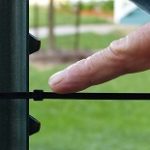
Attache zip ties firmly to a post.
What You Need to Make a Wire Ring
- Wire: We buy rolls of 2”X4” four foot tall galvanized wire mesh from a farm or building supply store. Many brands and types of wire mesh are for sale but we prefer Red Brand. It is stiff and strong and we usually only need one fence post to hold it up. Red Brand fencing is made in the US. Less sturdy wire mesh is cheaper but bends easily, rusts more quickly, and usually requires a few fence posts to hold it in place.
- Pliers: We unroll about eight feet of the wire roll on the driveway for cutting. Any type of cutting pliers will work to cut off a section but we find “Bernard” pliers perfect for the task. These are usually made for anglers and have a wire cutter and spring that automatically opens the pliers after a cut. They make slicing off a section easy and fast.
- Fence Post: With stiff wire mesh one fence post will hold a ring of wire in place around a tree. Wire mesh that readily bends may need two or three posts. We buy 6 foot posts, called T posts, at farm or building supply stores and pound them 18 inches into the ground 12” to 20” out from the tree’s trunk. A small sledge hammer makes a handy pounding tool. We then form a circle of the wire panel around the tree and fasten the ends together.
- Cable ties, sometimes called nylon zip ties, make joining the ends of the wire mesh and attaching the wire to the fence post easy. The ties come in various sizes. It takes big ones to run through the wire mesh and secure around the post. Twist wire also works to hold the ends together or attach the wire mesh to the post.
Putting a ring of wire around valuable young trees is almost certain to protect them from rubbing and browsing. Just be sure to do it before damage starts.
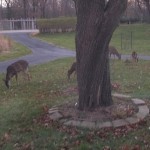
At Winding Pathways deer come into the yard. We protect young trees with fencing as seen in the back to the right.
LUNCH AND DINNER WITH BREAKFAST TOSSED IN: Deer love eating many landscape and vegetable plants. Although they have preferences, the hungrier the deer, the more likely they are to even eat plants they generally dislike. Garden books often list species of plants that deer do and don’t like to eat but beware, like humans, individual deer have food preferences. Although most deer may not like a particular plant species, others may consider it a dining delight. Deer seem to have regional tastes, so the plants they don’t like in Connecticut may be gourmet fare in Alabama or Iowa. Unfortunately, many plants that deer relish are the same ones homeowners like to plant, so protecting them is vital to success.
Damage to trees by rubbing is seasonal and normally only happens in the fall. In contrast browsing damage happens all year with deer generally eating softer vegetation during warm months and twigs during winter.
The Cure: Preventing deer from eating valued vegetation is difficult but here are some ways to either eliminate or stop it:
Fences
No doubt about it. A sturdy fence keeps deer away from plants and prevents damage. Fencing has downsides. It’s expensive, often unsightly, and it requires maintenance. A fence can ring an entire property or just an area that needs protection, such as around the vegetable garden. Generally there are two types of fence used to prevent browsing.
- Electric fences work well. Many newer ones are moveable and easy to install. Electric fences don’t need to be very tall. They are relatively expensive but their biggest disadvantage is that they sometimes give a shock to a careless homeowner or even a child. Many towns ban electric fences, so be sure one is legal before you buy one. We like fences made by Premier.
- Nonelectric fences work well to exclude deer but also have disadvantages. They are laborious to install and are relatively expensive. They can be made of heavy duty nylon or wire mesh. Deer are amazing high jumpers and can clear a six foot fence, so a deer proof fence should be eight feet tall!
Repellents
A good fence will prevent deer damage by keeping hungry animals away from desirable plants. Repellents are less certain but can help reduce damage. Repellents are most helpful when temporary protection is needed or where fences won’t work and they are less expensive. They have these disadvantages:
- Need to be reapplied often and always after a rain.
- Sometimes smell strongly.
- May not be suitable for use on vegetables.
- Only somewhat deter deer from snacking.
Our good friends Dave and Sue Kramer own Kramer’s Flower Farm and produce thousands of varied colored day lilies every year. Visit their farm in mid-summer and it is a sea of blooms. People love looking at colorful flowers but deer consider them lunch. Kramer’s farm is surrounded by woods, so they have to be vigilant in keeping deer way from their crop. Dave uses a home-made spray that keep deer at bay.
Kramer’s Deer Repellent Recipe
Ingredients:
One gallon of water.
Three egg yolks
One teaspoon garlic powder.
One teaspoon cayenne pepper finely ground
Directions:
Add ingredients and shake well. Leave in the sun for a couple of days. Shake again and filter through an old nylon stocking to remove lumps or they will clog the sprayer. Put in a standard sprayer and spray plants. Treatment needs to be repeated often and after every rain.
Deer don’t like the smell or taste of rotten eggs. Who would? Anyone who would rather not make their own egg based spray can buy commercial mixes. The one we use is called Deer Stopper and is made by the Messinas Company. The label says it’s made of putrescent whole egg solids, rosemary oil, mint oil and several inert ingredients.
After buying several inexpensive sprayers that clogged we bought a Stihl brand sprayer that works well and seems less likely to clog.
Whether using a home-made or commercial repellent remember it needs to be reapplied relatively often and always after a rain.
Direct Action
Winding Pathways is near Cedar Rapids, Iowa. Several years ago the City Council approved allowing citizens to hunt deer using archery equipment. Hunters need to prove proficiency with their equipment and special rules are in place to ensure safety. Each year hunters convert several hundred suburban and urban deer into chops and steaks. Deer meat is “free ranging, local, organic” and delicious.
Each year we harvest a deer from our property. This doesn’t stop deer damage but does provide us with food, and if enough people each take a deer, their population density and, thus, damage will decline. So, if it’s legal in your area, consider converting a deer to food. Normally a state and sometimes a local permit is needed. Look for a future Winding Pathways blog on how to harvest and dress a deer.
by Winding Pathways | Aug 30, 2016 | Mammals, Nature, Pests
A long-ago children’s story began something like this, “There is a mouse in my house. It is a very nice mouse. It has a long, long tail and shiny eyes. It pops out of its hole and runs. My mother likes the mouse, but she says, ‘A mouse does not belong in a house.’”
Well, guess what, a sure sign that fall is approaching is “a mouse in the house.” These tiny mammals realize that shorter days and cooler temperatures beckon winter. Finding a safe warm place to live with an abundance of food helps them survive the tough season.
At Winding Pathways we expect mice to appear with the first cool weather in late August or September. Once in a while we have seen one scurrying across the floor, but more often we have found their tiny black droppings on counters. Sometimes we have heard them scurrying about an upstairs closet.
Two types of mice inhabit houses. Both gobble birdseed and will eat nearly anything people do. They capable of doing damage and possibly spreading disease.
The common house mouse is a gray mammal native to the Old World that is now found everywhere people live. They like houses, barns, garages, and sheds but are rarely found far from buildings and live indoors all year round.
Several species of native mice live outdoors most of the year but move inside each fall. These are normally called deer or field mice and are beautiful tiny mammals with shiny eyes and white feet.
They store food, while house mice don’t. Find a pile of sunflower seeds in a shoe and the culprit is a native mouse.
We love wildlife but don’t tolerate mice in the house. So, each fall we plan an eviction campaign.
Here’s how we reduce mouse problems at Winding Pathways:
- Tighten up cracks and holes. Every fall we arm ourselves with a caulking gun and can of expanding foam and inspect the house from the outside and inside. We fill in any likely entryway for mice, which can squeeze through tiny spaces. Caulking also helps keep insects and cold air out of the house.
- Set up a trap line. Old fashioned mouse traps efficiently catch and instantly kill mice if set properly. Here are some effective trapping tips:
- Buy many traps and set them all at once. Try to catch all or most mice in one night, rather than just setting a few traps.
- Bait traps with peanut butter and set them with the trigger side against the wall where mouse evidence is noticed. Mice tend to run along walls, rather than across the interior of a room, so trapping success is usually best near a wall.
- Set traps in tandem. Instead of just setting one trap here and there along a wall double or triple them up side by side, again with the trigger side facing the wall.
- We don’t use poison. It seems cruel and inhumane and poisoned mice tend to die in inaccessible places and stink to high heavens.
- Encourage predators. We don’t have a cat but encourage raptors to visit our yard. They work year round reducing rodent numbers.
- Mice are encouraged by food. We keep all food in sealed metal containers or in the refrigerator and wipe up any spilled food. Wild bird and pet foods are loved by mice. Keep them in a metal can with a tight lid and dump out the dog or cat’s food dish in the evening so there’s nothing for nocturnal mice to eat.
Mice are fascinating animals that play an important role in nature, but they belong outside. It’s probably not possible to entirely eliminate them from a house but simple techniques will encourage them to stay outdoors.
by Winding Pathways | Apr 3, 2016 | Mammals, Nature, Pests
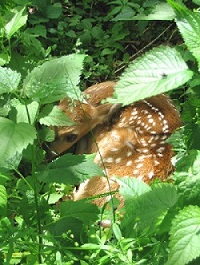
Deer drop fawns in our front yard labyrinth.
Few gardening experiences are as frustrating as discovering a patch of almost ready-to-bloom tulips or ready-to-pick green beans devoured by deer.
Over the past couple of decades deer populations have skyrocketed across North America, making gardening challenging. We have plenty of deer at Winding Pathways and have tried or researched many ways to either eliminate or greatly reduce damage. Here they are:
PLANT CROPS, FLOWERS AND SHRUBS DEER DON’T LIKE: This only sort of works. There are a few plants deer don’t like to eat. Books, blogs, and magazine articles contain lists of plants deer don’t like, but beware. As deer herds increase they get every hungrier, eliminate their favorite foods, and then chow down on plants they don’t particularly like. Also, deer seem to have regional preferences. Connecticut deer may avoid a certain plant that Iowa counterparts love. Winding Pathways Advice: Assume that sooner or later deer will eat just about any plant with only a few exceptions.
KENNEL A BIG DOG IN THE GARDEN: We haven’t tried this one but we’re guessing that the deer will soon figure out that the dog is tied or fenced in and they’ll eat plants just out of Fido’s reach. Winding Pathways Advice: Fido might help but don’t count on him.
SPRAY DEER REPELLENTS ON DESIRABLE PLANTS: It works much of the time. Many commercial repellents are on the market. We’ve made ours from egg yolks blended in water, strained through a nylon stocking to remove most of the thicker egg material and sprayed on plants. At best it is a temporary solution. Really hungry deer will eat the plants anyway, and rain washes most repellents off. Read labels. Some commercial repellents may not be safe on vegetables. Winding Pathways Advice: Repellents help but need to be reapplied after each rain and the deer will find the one plant you overlooked!
BUILD A FENCE: Tall mesh fences work. Electric fences work. Electrified mesh fences work the best. If you want a surefire way to keep deer out build a sturdy fence all the way around the garden. Unfortunately, there are some disadvantages of fencing as follows:
- Electric and tall nonelectric fences are often prohibited by town ordinances
- Fences are expensive but last a long time.
- Fences can be unsightly
- Fences are barriers to both deer and people. Building a fence means passing through a gate every garden visit.
Fences work. If nonelectrified they should be at least seven feet tall. Eight is better. Electric fences don’t need to be as tall and can be several strands of wire or (better) an electrified mesh.
Winding Pathways Advice: This is the one surefire way of keeping deer away from valuable plants. Just remember to close the gate!
WHAT WE’VE DONE AT WINDING PATHWAYS
We take a comprehensive approach to reducing deer damage to our labyrinth, vegetable garden and favorite landscape plants. Here is what we have done and are contemplating.
- Built a 7-foot tall nonelectric fence around our smallish vegetable garden.
- Built sturdy nonelectric fences around young trees.
- Use repellents frequently on special non edible plants.
- Buy a deer tag and harvest one deer per year. It’s legal where we live and we enjoy this
“local free ranging, organic” meat.
We’re considering buying and setting up an electric mesh fence around our labyrinth.
Farm and garden stores sell a wide diversity of nonelectric fencing. Our favorite resource for fences is Premier1. Their FENCES THAT WORK catalog is an outstanding resource. Check out Premier1 in Washington, IA.
by Winding Pathways | Dec 30, 2015 | Birds, Mammals, Nature, Pests
Watching backyard wildlife yields amazing sights and education. We recently noticed two things at Winding Pathways that reminded us about how many animals are downright smart.
Both involved a manufactured trap that supposedly catches House Sparrows. We have more of this pesky bird than we’d like so we set the trap under a feeder and baited it with cracked corn. A few minutes later an intrepid chipmunk entered the trap’s funnel-like door, feasted on seeds, and couldn’t find his way out. We gently released him and set the trap back on the corn.
A few minutes later we were amazed to see the chipmunk back and watch it tunnel under the trap to reach the bait! He’d learned that entering the trap brought trouble and figured out how to safely reach lunch.
Our sparrows are even smarter than the chipmunk. Not a single one entered the trap. Instead they feasted on corn and millet on the ground around the feeder. After a few hours they had eaten all the safe seed but they still wouldn’t enter the trap.
We now have new respect for the intelligence of both chipmunks and House Sparrows.
-
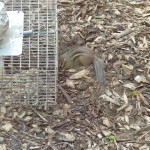
-
The chipmunk figured out how to tunnel under the live trap to reach the corn.
-
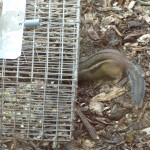
-
Having excavated, the chipmunk now enters the tunnel to get the corn.
-
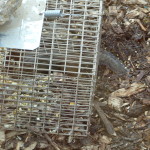
-
In and Under!
-
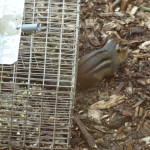
-
With pouches full, the chipmunk emerges.
-
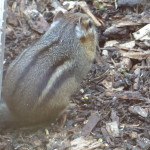
-
The chipmunk figured how to tunnel under the live trap, gather up the corn and emerged with pouches full.
by Winding Pathways | Nov 30, 2015 | Mammals, Nature, Pests
We love watching frolicking squirrels in our yard and every year we buy bags of corn for them to snack on. We draw the line when they climb up to feeders and gobble expensive seeds meant for chickadees, nuthatches, and woodpeckers.
Bird feeder companies all tout their “squirrel proof” feeders and a homeowner can spend a bundle on different feeders just to slow the flow of seed from feeder to squirrels’ mouths. Some preventions work better than others but a reliable company is Droll Yankee.
But, being partly of Yankee stock, we took the economical route. To thwart the hungry mammals we mounted our feeders on steel pipes and even ringed some with metal stove pipe. Somehow they managed to dig claws into the metal, climb and feast on expensive seed.
Then we discovered spray grease. It’s sold in hardware stores and is meant to spray on drawer slides, hinges, and other balky metal parts. We sprayed it on the metal pipes holding up the feeders. Squirrels gingerly put their feet on the pipe and backed off as soon as they felt the grease. It works.
Spray grease only lasts a few weeks and needs to be reapplied, but it is a simple way to discourage squirrels from climbing to feeders.
-
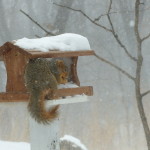
-
Even in the teeth of a storm, squirrels feast to tide them over.
-
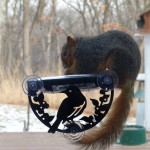
-
Boldly the fox squirrel hunkered down at the window feeder.
-
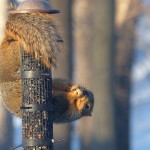
-
Quite the acrobat, this squirrel hung for more than 30 minutes eating seed.
-
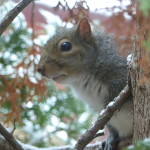
-
A cautious squirrel scoping out the action.
-
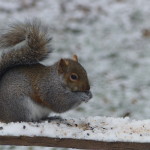
-
A hungry squirrel
-
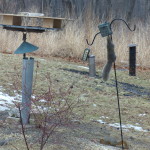
-
Squirrels have an amazing ability to climb just about any vertical pole.
-
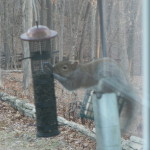
-
This squirrel learned to climb the metal deflector pole and reached into the hanging feeder.
-
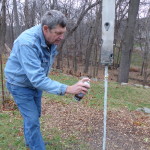
-
This grease works for a while. Remember to re-apply.


















